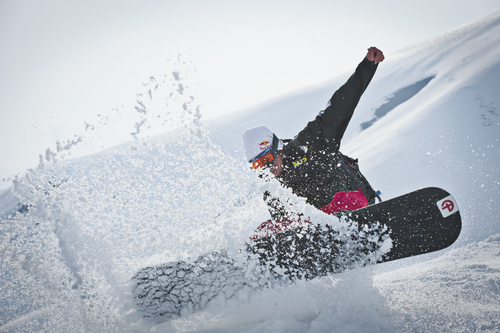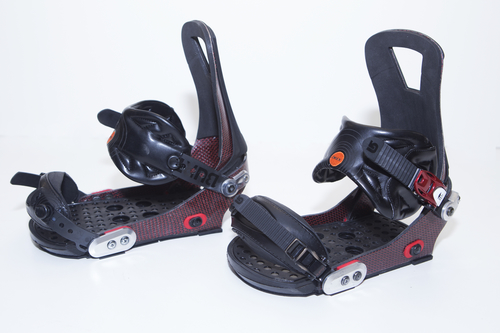Amanda Jones
28 January 2015: Whether it's designing personalised snowboard bindings for World Boardercross Champion Alex 'Chumpy' Pullin, or working with Australian skeleton athletes, a team of industrial designers from the University of Canberra's Faculty of Arts and Design is helping give our winter sports athletes the edge.
The team, including Stephen Trathen, Eddi Pianca, Carlos Montana Hoyos and Bill Shelley, has been working on two innovative design projects as part of an ongoing collaboration between the University and the Australian Institute of Sport (AIS).
The first, led by assistant professor in design Dr Pianca and fully-funded by the AIS, involves designing custom-built bindings for Mr Pullin, a two-time Boardercross World Champion and Olympian who was Australia's flag bearer for the 2014 Sochi Winter Olympics.

|
UC designers have custom-built bindings for Winter Olympian Alex 'Chumpy' Pullin. Photo: Felix Rioux/Redbull. |
"The AIS approached us to develop a binding for Alex that he could use in the World Cup after finding that the original bindings he used were no longer available. The original bindings were made from a carbon-nylon mix but the new ones are only made from nylon and are much thinner and lighter and break easily," Dr Pianca explains.
"When Alex lands after a jump, he exerts a huge amount of force on his bindings, eventually causing them to snap, sometimes after only one run. The company that manufactures the bindings no longer makes the type of specifications that he was looking for, so we were asked to develop something specifically for Alex."
The first pair the team developed was made from carbon but the bindings were far too strong and rigid, so they redeveloped and redesigned them using Kevlar – a high-strength material used to make bulletproof vests and racing sails.
The prototype took six months to create and was delivered to AIS snowboard program head coach Ben Wordsworth in December.
While Mr Pullin didn't have time to test them before competing in Sochi, he ran them through the Olympic course after competition had finished in Russia and then on the slopes in Australia.
Mr Pullin and Mr Wordsworth were happy with the design and requested three more pairs which were delivered in November ahead of the 2015 World Cup season starting in December.
"We've had problems buying commercial bindings for our boardercross team, so for the University of Canberra to create a customised pair of bindings is a huge step forward in binding technology," Mr Wordsworth says.
"It's a huge advantage for us and great for Alex's performance to have a set of bindings built specifically for him— this is something that would usually be quite difficult to achieve," he added.
Dr Pianca says students get a kick out of seeing real-life projects lecturers are working on in the classroom, including the new materials used.
"The use of carbon, Kevlar and other composites in the design field is becoming more widely used," he says. "With the bindings there is still a lot of development to go, these materials are very light and very strong and can be moulded to make almost any shape," he says.
"Students like to hear about the latest and greatest developments in the field, so for us to be able to embed this into the curriculum and show them designs we are working on is a huge plus. Students get excited, they like it."
Due to the success of Mr Pullin's binding's project, the AIS are keen to engage the University of Canberra further and have asked them to develop a binding that is adjustable and that can be used by other athletes in the Australian boardercross team.

|
The UC-designed bindings Alex Pullin will wear at the 2015 World Cup. Photo: Michelle McAulay. |
Dr Pianca says that project, due to start this year, presents a bevy of new challenges but they are looking forward to the task.
"We'll look at Alex's bindings and try and figure out how we go from this custom-built design to one that's fully adjustable. Different riders will want different high-back adjustments and different mounting settings, so we need to come up with an idea that meets the individual needs of each rider," he says.
University of Canberra researchers haven't just been helping snowboarders gain the advantage on the ice. The same team, this time led by assistant professor in industrial design Dr Trathen, has also been working closely with the AIS and the Australian skeleton team by implementing new design features on their sleds.
The designers developed a series of composite material components and aerodynamic designs for five skeleton sleds, with the aim of increasing the aerodynamic advantage and steering control. Previous research had indicated that extending the pan to its maximum allowable length of 1,200mm could improve the aerodynamics.
Researchers also built body casts of the individual athletes' torsos to develop custom-made body supporting shells – giving them a greater feeling of security and comfort when plummeting head-first down the icy track at speeds of up to 135km/h.
"It was a very user-centred process in which we worked closely with the coaches and athletes at the AIS," Dr Trathen says.
"The changes were slight with the aim of giving our athletes the edge, which in these competitions can mean the difference between a gold medal or the silver."

|
Designers Stephen Trathen and Eddi Pianca in the UC workshop with students. Photo: Katherine Griffiths. |
While the sliders didn't have the success they'd hoped for at Sochi, they did record some top five and top 10 results in the lead up World Cup events, with Michelle Steele claiming third in Calgary and fourth in Konigssee. Fellow slider Lucy Chaffer recorded top 10 finishes in the first two World Cup events, while John Farrow placed 12th at St Moritz and 20th at Calgary.
"We had great feedback from the athletes and the coaching staff," AIS senior physiologist and skeleton program manager Dale Chapman says. "The testing we had done on the sleds found the shape and design was faster than the commercial product."
Dr Chapman says the jury that scrutinises the sleds was also impressed with the changes made to allow for better aerodynamics.
"The sleds are more comfortable and the athletes are more confident going into a race knowing the shells have been designed specifically for them. We're very thankful to the University of Canberra for their help and we couldn't be happier with the collaboration," he says.
Dr Trathen says these projects highlight the ability of the University to work collaboratively and across various disciplines to address issues of sports design.
"Sometimes it's not about the end product but how a designer or a design-approach might aid the team in coming up with an innovative, creative solution."
A third project underway at the University is investigating the links between head knocks and the effects on balance in skiers and snowboarders. Dr Trathen is also involved in this study – along with professor of physiotherapy Gordon Waddington from the Faculty of Health and associate professor events and tourism management Tracey Dickson from the Faculty of Business, Government and Law.


